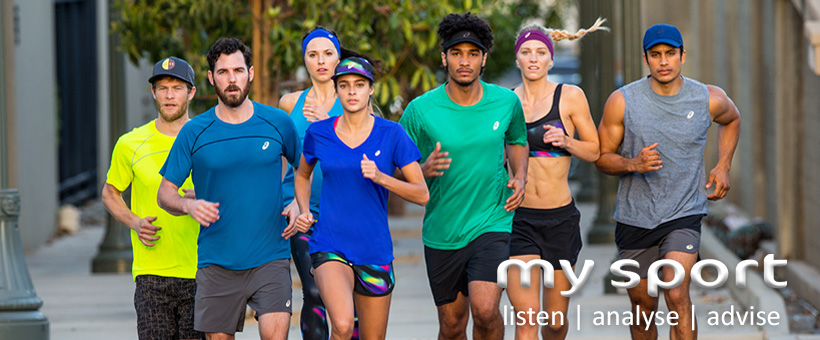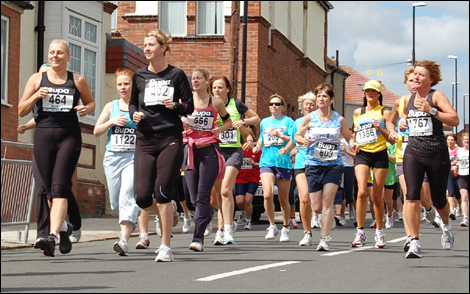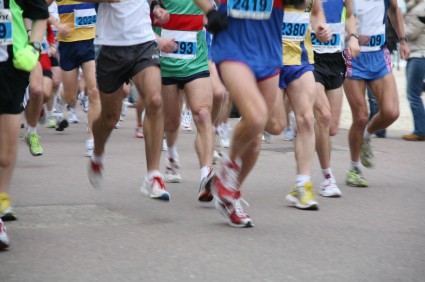Uncategorized
Beat Over-use injuries
What is an over-use injury? The majority of injuries affecting endurance sports are the result of repeated ‘submaximal’ loading. This is loading which isn’t large enough to tear a muscle or break a bone but leads to a gradual breakdown of tissue. These injuries generally progress from a mild niggle, which is often ignored, to pain which has a progressively greater impact on continued activity and pain at rest. It is also common that after a little discomfort the mild pain ‘warms up’ and exercise feels normal which only allows the injury to worsen. Factors that influence the development of over-use injuries include biomechanical issues, technical issues and training errors, which I'll go into more depth in below, and include some self-help tips. Biomechanics Biomechanics is concerned with how the body moves and what effects the movement of force through the body. An assessment of an individual’s biomechanics will reveal what is tight, what is weak, what is poorly controlled and what structural problems exist. Typically biomechanics are not considered until something goes wrong but should always be looked at along with technical problems to get an understanding of what forces are being put on the body and how the body is able to deal with them. The human body is very good at compensating and will find a way of managing as best it can to get a job done. It is when these coping mechanisms fail that excessive overload and injury develops. When considering the forces applied to the body the important thing is the balance between mobility and control. The more mobility you have, the more movement you need to control. Stiffness is also important to consider as the body, like everything, moves in the path of least resistance. If a structure is stiff it is able to resist a large amount of force before breaking but the force will move to the next easiest point. It is controlling the movement that is key to preventing injury. Technique Technique has a big influence on the size and direction of forces applied to the body. Problems with technique reduce movement efficiency, increasing the effort you need to put in for the same result. This increases the amount of force that the body has to deal with leading to earlier fatigue and further loss of form. With loss of efficiency, we can see an immediate effect on performance - a runner may lose form in a sprint finish, effort increases, speed decreases and they get caught on the line. Over time, persistent inefficient movement increases the risk or frequency of injury. Common technique problems that reduce efficiency include: Over striding Shuffling Bouncing Twisting/rotating Training errors Training error most commonly relates to an aggressive increase in quantity and/or intensity: Too much - too hard - too soon. Over-loading the body is necessary to stimulate change but progression of training loads and intensity needs to be carefully controlled and increased over months and years as the body develops. As muscle strength increases the tendons, attachments to the bone and the underlying bone strengthen to be able to transfer force. If they are loaded too frequently, with too much intensity or for too long they can become fatigued, their ability to control and transfer load reduces and they can degenerate or inflame and become painful. It's worth noting that changing loads can involve changing the way force is applied, such as: Changes in running surface- the cambers of roads and footpaths or changing from road to trail, for example, involves changing angles of loading and the hardness or stability of the running surface. Ageing footwear- compression on part of the sole can lead to a change in the angle that the foot strikes the ground, changing the rate and amount of pronation through the foot and ankle. Changing techniquecan lead to the loading of weak tissue and adequate time is required to allow the development of appropriate strength. How to reduce the risk of injury To reduce the risk of injury we need to look at how much load is put on the body, how the body is able to manage this load and then control how the training loads are progressed. Following an individual biomechanical assessment, it is possible to address structural problems and develop an individual conditioning program for mobility, strength and endurance. Assessment of your running action will highlight problems with movements that increase load and reduce efficiency. Sorting these problems will help to reduce the stress that can lead to injury and also increase speed. Keeping a training diary allows you to look back over your training, how you progressed and what happened leading up to injury. This will give you a better understanding of your tolerance to training, will help to predict a safe rate of progression and where weaknesses leave you prone to injury. A program can then be designed which is challenging enough to force improvement while minimising the risk of injury. Self-treatment & prevention tips: When you first become aware of any little niggles try the following: Ice massage Massaging with an ice cube in the tender area can help to reduce any inflammation, but be sure to keep the ice moving to avoid ice burns. Stretching To reduce the tension in tight muscles but keep this comfortable, there shouldn’t be any pain and if you suspect a tear avoid this initially. Self-massage While typically less intense than a massage received in treatment, self-massage on a regular basis is a great method of reducing muscle tightness and in the case of muscular injury is more appropriate than stretching. Rest Rest is a relative term! It depends on severity. Reductions in training volume or intensity can be enough to allow mild symptoms to ease and if not, more severe restrictions in activity up to complete rest could be necessary, along with treatment. While easing off running, cross training can be used to prevent loss of strength and fitness. The earlier you recognise a problem isn’t easing and seek assessment and treatment, the less likely you are to suffer prolonged pain or risk enforced rest from training.
Read More
When Do You Need to Buy a New Pair Running Shoes?
BY MARC LINDSAY MAP MY RUN BLOG One of the great things about running is you don’t need a lot of gear. That said, a good pair of running shoes is a must — and you’ll need to replace them frequently to avoid common overuse injuries. When you need to replace them is subject to debate. If you ask 10 different experts, you’ll likely get 10 different answers. While there is no one right or wrong answer for everyone, there are a few general wear-and-tear signs that can signal it’s time for a new pair of kicks. Why Running Shoes need to be replaced. Running shoes are designed to be protective and supportive. Once the exterior sole or tread, midsole and upper begin to wear, your feet, ankles, knees and hips will have to absorb more of the pounding as you run on the road. When the midsole, (which provides a majority of the cushion on impact), has been compressed enough times, it won’t provide those shock-absorbing qualities that can help to reduce the likelihood of an overuse injury like patellar tendonitis, Achilles tendonitis and plantar fasciitis among others. “Air is one of the key ingredients to the foams that are used in running-shoe midsoles. This is what allows the shoes to be light and comfortable underfoot,” says Cori Burns Run Category Manager at Under Armour. “In turn, over time and under the repetitive stresses of running, the foam structure can break down or compress.” The general range for when a midsole begins to break down is between 300–550 miles. The number of miles you run until the midsole breaks down varies so greatly due to a number of factors that can differ from person-to-person and shoe-to-shoe. It isn’t recommended to judge midsole breakdown based on time, since the number of miles you run from month-to-month can differ. “In addition, the outsole rubber, under the sheering forces of foot-strike will also wear down over time. Similar to the tread on tires,” says Burns. “To maximize the cushioning underfoot and keep your feet and joints feeling fresh, it’s best to refresh your shoes.” Factors that affect Midsole Breakdown Because of the variances of anatomy and training habits, midsole breakdown can vary greatly between runners. “The amount of load (weight of the runner, number of miles run in the shoes, wearer’s efficiency and foot-strike) plays a significant role in the breakdown of a shoe over time. However, the foam composition and how resilient it is to ‘compression set’ will also play a major role,” says Burns. Below are a few factors that should be considered when determining how often your running shoes need to be replaced: • How much do you weigh? Larger runners need to replace shoes more often since the compression of the midsole will be much greater than it is from a smaller runner. • What’s your running style? Runners who have an efficient stride and are light on their feet will not wear out running shoes as quickly as runners with an excessive heel strike who pound the pavement. • Where do you run? If you run primarily on the road, your running shoes will wear faster than they will if you run on grass or dirt trails. • What kind of shoe do you have? Different models wear at different rates depending on the quality of the materials in the midsole. Minimalist shoes can wear even quicker than other models. Signs that it’s time to replace your shoes Not everything needs to be scientific. If your running shoes have started to feel flat and you begin to notice aches and pains in your feet, ankles and knees, it’s probably a safe bet it’s time for a new pair. “It’s often said that a runner should replace their shoes after about 300 miles,” notes Burns. “But it’s important to consider the underfoot feel and the outsole tread pattern as well. If the shoe still feels lively, it is likely fine to continue pounding out the miles. But, if the midsole feels dead and if the outsole traction has worn away, it’s a good sign to refresh your shoes.” Here are some other basic wear-and-tear signs that signal the need for a trip to your local running store: • Visible creases or cracks in the midsole. • A worn outer sole showing the midsole, or an outer sole that’s rounded or bald like a car tire. • An unsupportive heel counter. • Tears in the upper. • The shoe sole is visibly worn on either side so that it leans to one side on a flat surface. • The midsole doesn’t feel as springy as it did when they were purchased. If you’re still on the fence, try on the same model you already own. If there is a noticeable difference in how they feel, you might want to go ahead and make the purchase. Tips to make your running shoes last longer Whether or not you’re a high-mileage runner, replacing your running shoes every few months can get expensive. To make your running shoes last as long as possible, there are a few things you can do to improve their longevity. While it might seem expensive at first, purchasing two or three pairs of running shoes and alternating them can help them to last much longer than they would if you only run in one pair. “having a couple of pairs to rotate throughout the week can alleviate the stress on a single pair, and ultimately allow both shoes to last longer,” says Burns. This is due to the compression of the midsole, which takes close to 24 hours to return to its normal shape. By alternating pairs if you run one night and then again the next morning or afternoon, you’ll give your joints more protection and increase the longevity of your shoe. It’s also a good idea to switch up your running surfaces instead of sticking to the sidewalk. “Running on softer surfaces, such as grass or a treadmill can help to preserve your shoes,” says Burns. Since concrete is a much harder surface, your shoe’s midsole will have to compress more to absorb the impact of your foot strike. By alternating runs on softer surfaces like dirt, grass or even the treadmill every once in awhile, your shoes won’t have to work as hard to provide the cushion and support your body needs. If you’ve gotten into the habit of wearing your running shoes while running errands, this also decreases their lifespan. Only wear your running shoes while running and get a separate pair of shoes to wear while you’re out in town.
Read More
Know your foot type
When it comes to running shoes its essential that you establish what 'type' of foot you have. Normal everyday running shoes fall into one of three categories - Neutral Cushioning, Support and Motion Control. Most people fall into the 'Support' category. A simple way of establishing your shoe type is to conduct the 'wet test'. Remember, this is a useful indicator but for a more accurate test we recommend that you visit us in store for a free comprehensive video gait analysis consultation. The Wet Test works on the basis that the shape of your wet footprint on a dry piece of paper roughly equates to the amount of stability you might need in your shoe. It will show you what features you should look for and equip you with the basic knowledge you need to make the right decision. The Normal Foot Normal feet have a normal-sized arch and will leave a wet footprint that has a flare, but shows the forefoot and heel connected by a broad band. A normal foot lands on the outside of the heel and rolls inwards slightly to absorb shock. It’s the foot of a runner who is biomechanically efficient and therefore doesn’t need a motion control shoe. The Shoe for You: Stability shoes with moderate control features. The Flat Foot This has a low arch and leaves a print which looks like the whole sole of the foot. It usually indicates an overpronated foot – one that strikes on the outside of the heel and rolls inwards (over pronates) excessively. Over time, this can cause many different types of overuse injuries. The Shoe for You: Motion control shoes, or high stability shoes with firm midsoles and control features that reduce the degree of pronation. Stay away from highly cushioned, highly curved shoes, which lack stability features. The High-Arched Foot This leaves a print showing a very narrow band or no band at all between the forefoot and the heel. A curved, highly arched foot is generally supinated or underpronated. Because it doesn’t pronate enough, it’s not usually an effective shock absorber. The Shoe for You: Cushioned (or 'neutral') shoes with plenty of flexibility to encourage foot motion. Dont make the mistake of buying support or motion control shoes.
Read More





